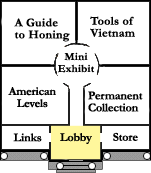
|
|
Table of contents |
A Guide to Honing and Sharpening
Modern Sharpening Technologies
|
In the United States, three sharpening technologies seem to be the most popular with two other technologies waiting in the wings. |
|
| 1: Oil Stones | |
| 2: Waterstones | |
| 3: The Scary Sharp System | In the past decade abrasive companies have been introducing abrasive paper in fine and finer grits. Originally intended for the jewelry industry, grits up to 8000, allow a jeweler to sand progressively finer until polished. Woodworkers have adapted these abrasive sheets to substitue as single-use stones. One glues a sheet of paper onto a flat surface and then sharpens until the paper wears out. This is an excellent way for a beginner to sharpen without the initial expense of a quality superfine water or Arkansas stone. It gives tremendous flexibility in grit and allows for very wide abrasive surfaces. The downside is of course the time and expense of replacing the paper. |
| 4: Diamond stones | A most important introduction has been stones made from industrial diamonds. Diamond powder is bonded to either a steel or plastic substrate. In use the stones are lubricated with water. In their coarser grits diamond stones are great for flattening the backs of edge tools and or helping maintain the flatness of water stones. Stones in finer grits are becoming available and some people like how fast they cut. Super-fine diamond stones for finish honing are not available but some people are using diamond paste for this purpose. |
| 5: Hard ceramic stones | Several manufacturers have begun to introduce hard ceramic stones into the market. The stones are made of the same aluminum oxide used to make Japanese waterstones but the material is bonded together into a hard mass. The stones use water not oil. Initial reports are very good and this is an area to watch. |
|
A Note on Modern Steels For the past two centuries the best steels for woodworking in the West were made from what was called "Cast Steel". This process became extinct around the Second World War and various alloy steels came in vogue. Recently toolmakers have been experimenting with fairly complex alloys, the most popular called "A2" steel. These steels have a common trait of being able to hold a very fine edge but also retain toughness against wear - so the blade lasts longer between sharpenings. Some experts believe that A2 steel, due to its crystaline structure is incapable of being sharpened as finely as older steels but the new alloys have become very popular. Sharpening them takes slightly longer and the harder abrasives of waterstones are an advantage. However, Arkansas stones still work well, but a bit more slowly and of course have the feature of remaining flat. |
|